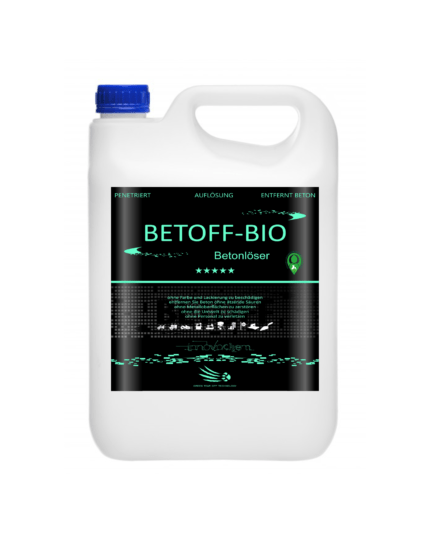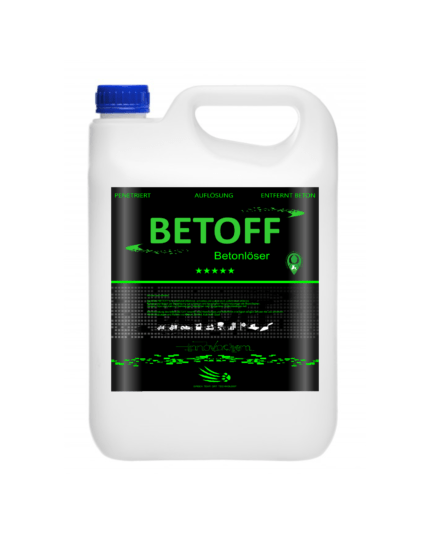Concrete dissolver BETOFF is the best product on the market, you want to check it? You need to buy it!. Even while we enjoy working with concrete, we don’t want it to cover our trucks, tools, and other equipment. Unwanted concrete coating makes equipment heavier, shortens its lifespan, and looks dirty and unappealing. So figure up a creative approach to get rid of dried-on concrete stains.
BETOFF and BETOFF-BIO are molecular cement solvents created by Innovatech. For removing hardened concrete from tools, vehicles, and other equipment, it is a substitute for acid. It makes use of an active component that is present in one of the endemic plants’ syrups. The substance does not damage paint, poses no risk to personnel or equipment, and decomposes naturally (BETO-BIO). It has long been known that endemic components have an impact on concrete. They are frequently used in several regions of the world to postpone the setting of cement products such as mortar.
According to a study published in December 1957, certain plants can have an impact on both fresh and hardened concrete. Hardened concrete is unaffected by the dry component, but the plant’s solutions can be highly caustic. A few years later, a resourceful and determined chemist at Innovatech has taken advantage of this vulnerability to safely remove hardened concrete from a range of ordinarily challenging-to-clean surfaces.
BETOFF fluids dislodge cement from whatever surface it has adhered to by rupturing the ionic connection. BETOFF and BETOFF-BIO fluids, in essence, disintegrate the cement so that it can be washed away by converting positive ions into integral ions in the hardened matrix.

Concrete dissolver. How Is BETOFF-BIO Operational?
Utilizing BETOFF-BIO is simple. You first soak it into the concrete until it hardens. The liquid is administered to the same location after 15 minutes. Typically, concrete begins to soften after 20 to 30 minutes. Following this period, water should be used to rinse the dissolved concrete. Thick layers can be removed by applying more than once.
Concrete Dissolver: A Simple Method for Masonry Tool Cleaning
One method for softening old mortar on masonry tools, equipment, and vehicles is to use a concrete dissolver. Unwanted concrete deposits are also removed off glass, metal, most plastics, painted, and wood surfaces by its moderate acid and foaming agent.
The easiest approach to safeguard tiles during grouting is to prevent cement stains from building up on them, although this isn’t always achievable.
Concrete Dissolver: What Justifies My Requirement for One?
Cleaning the tools used for masonry work is one element, and cleaning up masonry residue is another. Regarding the latter, BETOFF-BIO Concrete Dissolver handles it.
Use BETOFF liquid if you’re having trouble with extremely old concrete, such as on a concrete mixer. The strongest liquid available is this one!

Asking the primary question comes first.
- What issue do you have?
- Are you remodeling your house right now, and your patio is made of cement? Are there traces of concrete visible on your wheelbarrow’s tires?
- Is there firm cement mortar on them now that your father recently tiled the bathroom?
- Have you noticed that the concrete has gotten over the stucco wall’s boundaries?
- Has the ready-mixed cement been dumped in an unwelcome location, like the bathroom?
- Has the concrete around your window and its frame solidified?
Has anyone ever unintentionally left tools covered in concrete out in the sun for a long time?
You can use one of our concrete removers and cleansers safely if you can answer any of the preceding questions.
Concrete dissolver. Why Apply It?
You can either discard the tools or clean and polish them back to their original shine. You spend a lot of money on tools and gear. Maintaining your equipment will help you save money. Clean tools perform better!
“As soon as tools and equipment are no longer in use, they should be washed with water to remove all concrete,” says stonemasonry instructor J. Kreh. Concrete can rust or harm metal components and is difficult to remove once it has solidified. The concrete solvent Betolix-Bio is helpful in challenging situations.
Concrete dissolver. How does it operate?
The product sprays, and the solution foams. The chemicals mainly separate the bonds that harden the concrete and mortar as they break them down.
Give the product fifteen to thirty minutes on the surface. After that, remove any remaining cement by wiping or rinsing.
If you feel that the product was not applied enough the first time, go back and apply it again, letting it absorb before wiping off any leftover residue.
Concrete dissolver. For what purpose is it used?
Concrete Stain Remover is ideal for cleaning dirt from tools, machinery, cars, and other non-concrete surfaces that could unintentionally get discolored by splashes of concrete or mortar.
a concrete removal product that is dried out. There’s Betolix everywhere mortar or concrete can set! The following instruments can be cleaned with the concrete residue cleaner:
- Examples by Category
- Cleaning supplies hoses, brushes, brooms, and buckets
- Concrete implements Couplers, hammers, gauges, and floats
- Tools for cutting and shaping Wet saws, chisels, and brick breakers
- digging implements rakes, tampers, diggers, and compactors
- Tools for measurement and layout of Centimeters, squares, and levels
- Metals Carbon steel, stainless steel, aluminum
- Other scaffolding, wheelbarrows, tool buckets, and tongs
- Equipment for mixing Shovels, mud carts, mortar boxes, and mortar hoes
- Additional surfaces Glass, rubber, most polymers, wood, and painted wood
- Automobiles Trailers, forklifts, and cars
Removal of concrete residue. Why won’t it function there?
You must safeguard the regions where the concrete remover has been purposefully placed since it interferes with the bonding property that hardens concrete. As a result, applying such a product straight on concrete or the mortar spaces between tiles is not advised.
Before using concrete remover, always carefully read the product label. For advice on how to use a device like this properly, you can also consult professionals in a home renovation or building supplies store.
Concrete dissolver. Concrete remover that has dried. Is the solvent for Betolix-Bio concrete safe?
You and your tools are safe, yes!
A moderate acid derived from fruits and vegetables, coupled with wetting, buffering, and foaming additions, is the primary component of many solutions. Water should be used to dilute the concentrate. The product may be applied with ease thanks to the spray nozzle.
In addition, this restorative cleaner is:
- Degradable in nature
- steady
- Not dangerous
- No smell
- VOC compliant—it doesn’t release any dangerous fumes.
- Non-corrosive
*Performed better in a series of metal tests on carbon steel, stainless steel, and aluminum than two harsh acids (phosphoric and hydrochloric).
Concrete Remover. Think About Taking These Safety Measures
Examine the product’s label!
For complete application instructions, read the product instructions before using.
Put on safety gear.
Put plastic over any spray locations you don’t want.
Before using it for the first time, test. To be sure, try spraying a tiny area and seeing what occurs.
Concrete Remover. Betolix Concrete Solvent application (in 5 simple steps)
For smeared stucco, mortar, or concrete, use a concrete stripper sprayed on.
Give it time to work. Give it at least 15 to 30 minutes to activate on the surface. If the stain does not go away, reapply.
Using a towel or hard brush, gently remove the grayish substance.
Use a washer or hose nozzle to rinse the residue with water.
After cleaning, let the area dry.
Concrete dissolver. What affects the outcome in the end?
Weather: Steer clear of wet days as they will prevent you from using the product. Additionally, stay away from hot days as they might cause the mortar to dry up quickly by heating the surfaces.
During the curing time, the mortar and concrete solidify and become more difficult to remove.
Type of mortar: It should be remembered that high-strength mortars can need to be applied several times.
Amount of saturation: Mist the unclean area; do not mist the surrounding regions. Try applying additional goods once more if this is insufficient. Don’t go overboard.
Weather: Moderate temperatures, approximately 21 degrees, are ideal for this.
Concrete dissolver. Hydrochloric acid
Hydrochloric acid was, and still is, the old way of cleaning stone. Though somewhat riskier, this approach may also be successful. It may lead to tool damage and rust.
Concrete dissolver. Appropriately store and dispose of
Used concrete dissolver should be kept indoors at a comfortable temperature, out of direct sunshine, and away from youngsters. The best temperature to store concrete dissolver is between 12 and 14 degrees.
Despite being biodegradable, BETOFF-BIO concrete remover shouldn’t be used for compost or lawns. Any leftovers should be disposed of with home rubbish or in the building site bin.
It can be hazardous to pour it down toilets, drains, or bodies of water.
Concrete dissolver. What features ought a concrete remover purchase have?
There are numerous brands of removers for concrete out there. The majority’s names include either mortar remover or concrete remover.
Masonry supply businesses and home improvement stores sell cleansers and removers for concrete. Determine whether the concentrate you are receiving requires you to dilute it yourself or if it is.
View the completed item.
Concrete dissolver. What is the required container size?
It varies. You need extra for larger areas. It’s easy to use because of the spray. The solution produced in a bucket can be spread with a brush if you need to cover a broad area.
The general rule for diluting any solution is as follows. Practice combining the appropriate amounts of water. Use a bucket or other clean container to dilute the product. The ingredients should not be mixed in the product’s original packaging.
Packages including BETOFF and BETOFF-BIO are available:
- One-liter
- Five liters
- Twenty liters
Purchase everything required for surface cleaning. Speak with an expert in professional dirt removal for the finest advice. See what other bricklayers and do-it-yourselfers are using. Get in touch with the product’s seller. A trustworthy dealer will be knowledgeable about the goods they offer and how to use them.
Concrete remover. Find out more about terminology
Definition brief for the term “masonry”
Concrete is made of cement, aggregate (gravel and sand), and hardener to form a solid building material.
Chemical a mixture that dissolves and activates solids chemically.
Waiting period Determine how long it will take the product to start working.
Cement is a sand-and-water combination used to seal cracks and fill in seams.
A binder used to bind bricks, stones, and blocks, mortar is composed of cement, sand, and water.
Portland stone cement. the main component of masonry. a powdery component consisting of trace minerals and burned lime.
Stucco is a layer-by-layer application of cement and water plaster used to finish both interior and external walls.
Concrete dissolver. Does maintaining your tools matter?
Indeed!
It is essential to properly maintain your tools.
In regular masonry work, cleaning is the final phase. The longer concrete is left on a surface, the more difficult it is to remove.
Concrete remover. What More?
Make as little damage as you can.
Use a tripartite strategy:
- Avoid. Apply mortar or concrete with dexterity and proficiency. This is how you defend yourself initially. After using concrete for a day, wash down the tools.
- Try to be as gentle as you can. Masonry equipment is highly prone to damage.
- Avoid using strong chemicals. Apply potent compounds as a final option. Certain mixtures will rust.
